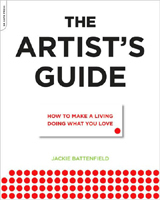Minus Space & entrepreneurial art practice (2009)
The following is a “best practice” on Internet-based communications from Jackie Battenfield’s The Artist’s Guide: How to make a living doing what you love.
Creative Business & Entrepreneurship | 1 October 2010
Minus Space & entrepreneurial art practice

In 2003, artists Matthew Deleget and Rossana Martinez developed an ambitious curatorial project, MINUS SPACE, which began as a modest website to encourage and receive a critical dialogue around the language and ideas of Minimalism.
MINUS SPACE has now grown to showcase the reductive art of fifty international artists and presents four exhibitions annually in its Brooklyn project space, as well as curatorial projects in other internationally recognized venues, such as the MoMA affiliate P.S.1. It publishes an online log, a directory of collaborating artists, a comprehensive chronology of events concerning the development of reductive art on the international level, and a comprehensive directory of links to related websites. Matthew Deleget describes the process below:
“We were making a specific kind of art that people could only explain by what went on forty years ago, which was Minimalism... We realized that the curators organizing shows we were in were having a hard time formulating the language and the ideas correctly, so we had to work heavily with them. The venues didn’t have a good understanding of what we were doing. Therefore, critics were not getting a clear message, so they couldn’t write about our shows. Collectors weren’t buying the work. So we were doing shows we felt good about, but clearly the message wasn’t getting through.
We began by collaborating with artists in our local Brooklyn community and put up online portfolios of their work... We asked certain artists that we held in high regard to recommend other artists, and so on. We were interested in finding the best work out there. We have artists on our site that are in their eighties all the way down to their twenties... from all over the globe, different ethnic backgrounds, different conceptual standpoints and artistic strategies. It’s pluralistic... It’s a community of practice.
We also needed to contextualize what it was we were doing. We started linking up to exhibitions that were relevant to our project. We have this huge comprehensive directory of links which brings a lot of traffic back to our site. [Through these links we have been invited] to do projects in spaces, participate in exhibitions that they’ve curated, included in print portfolios, and catalogues.
We have leveraged hundreds of exhibitions for people. We’ve had people’s work go into many collections... Our project is about community and ideas. It was never about money. We started this project with USD$75, and we haven’t spent much more on it. We have, however, spent the last five years of our lives on it, but it’s a huge labor of love.
My main concern is my community. I have been able to meet fantastic, thoughtful people from around the globe who I feel like I’ve known my entire life. We share a common experience, value system, and an interest in the work we make... I feel like our project is somehow interrupting the natural progression of things by connecting an artist in NYC with an artist in Australia with someone in the Netherlands. I don’t believe it would have happened naturally had it not been for MINUS SPACE.”
MINUS SPACE is a model that could be followed when developing any online community. Not only does it connect the artists to other practitioners in their field, but it also provides a vehicle to help them challenge, critique, and expand their individual practice.
This excerpt is on page 317 in the chapter: “How to build community to survive being alone”. The Artist’s Guide: How to make a living doing what you love (2009) is published by Da Capo Press. For more information and reviews, click the link above the article.